When you're making kimchi, salting the cabbage first isn't just tradition – it's science. The salt triggers osmosis, drawing water out of the cabbage cells over several hours, which creates the perfect environment for beneficial bacteria to thrive. You'll need about 1.5 cups of sea salt for proper brining, aiming for a 2-5% concentration that kills harmful bacteria while promoting good ones like Lactobacillus. This vital step not only preserves the cabbage's crunch but also kickstarts the fermentation process that transforms simple vegetables into a probiotic-rich superfood. The art of kimchi-making holds even more fascinating secrets in its 2,000-year history.
The Science Behind Kimchi Brining
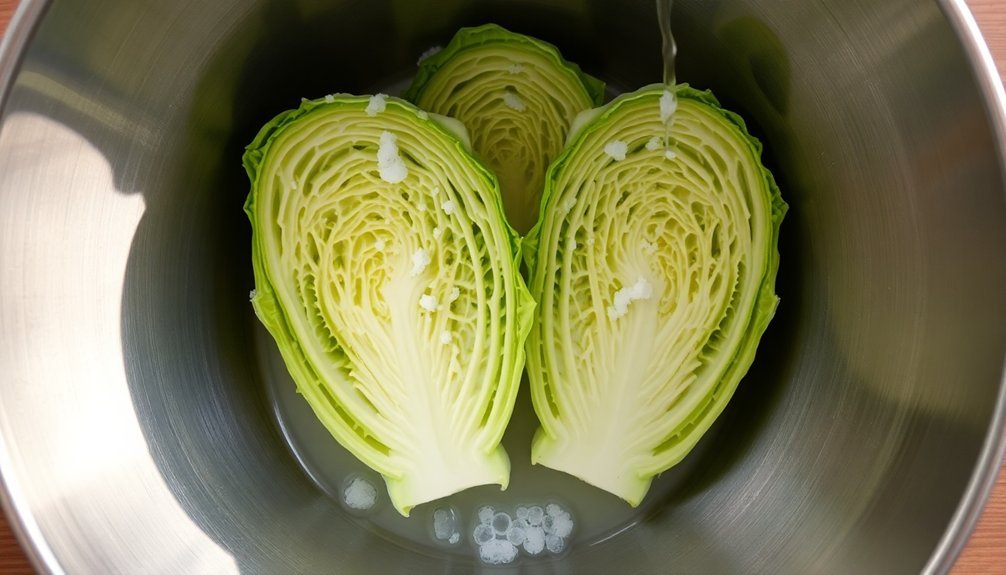
The kimchi-making process relies heavily on a fascinating scientific phenomenon called osmosis. When you salt your cabbage, you're triggering a precise molecular dance where water molecules move through the vegetables' cell membranes from areas of higher concentration to lower concentration. This movement causes the cabbage cells to release their water content, leading to the collapse of their cellular structure over a 6-hour period. Traditional Korean recipes recommend using non-iodized sea salt for optimal results.
You'll notice your cabbage becoming more pliable as the salt draws out moisture, creating an environment that's essential for both preservation and fermentation. The salt concentration, typically between 2-5%, serves multiple purposes: it prevents harmful bacteria from growing while creating ideal conditions for beneficial Lactobacillus bacteria to thrive.
These good bacteria are critical for converting sugars into lactic acid, which gives kimchi its characteristic tang. The resulting brine solution isn't just a byproduct – it's a significant component that keeps your vegetables submerged, maintaining the anaerobic environment necessary for proper fermentation.
When done correctly, this process creates an ideal pH level of 4.2-4.5, ensuring your kimchi develops its signature flavors and preservative qualities.
Essential Salt Types for Kimchi
Building on our understanding of the brining process, selecting the right salt makes a significant difference in your kimchi's flavor and fermentation. Traditional Korean solar sea salt (Cheonilyeom) stands out as the premier choice, particularly when it's aged for three years. You'll find this salt has lower sodium chloride content and higher mineral concentrations, which promote ideal fermentation. The quality impacts fermentation so significantly that wrong salt choices can create unwanted bitter flavors.
| Salt Type | Key Benefits | Best Use Case |
|---|---|---|
| Cheonilyeom | Rich minerals, slow fermentation | Traditional kimchi making |
| Shinan Sea Salt | UNESCO-certified, ideal sulfuric content | Commercial production |
| Kosher Salt | Readily available, no additives | Decent substitute |
| Regular Table Salt | None for kimchi | Avoid using |
If you can't source Korean sea salt, kosher salt serves as your next best alternative, though it won't provide the same mineral benefits. Avoid table salt or imported sea salts, as they can cause your kimchi to ferment too quickly and develop an overly sour taste. The ideal salt should be coarse and free from anti-caking agents or iodine. When using Shinan sea salt, you'll notice it's less salty than regular salt, allowing you to achieve the perfect balance of flavors in your kimchi.
Traditional Korean Brining Methods
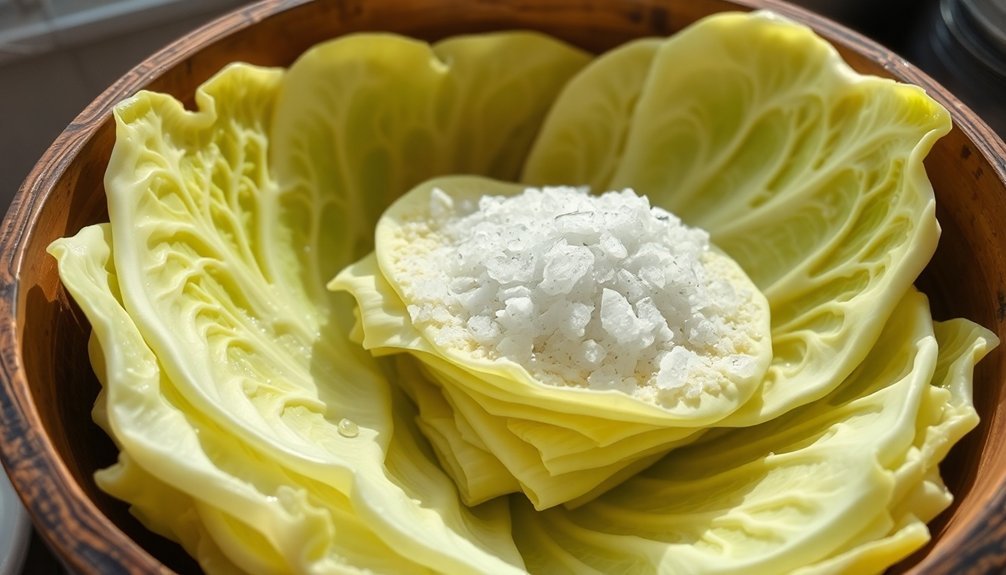
For successful kimchi preparation, mastering traditional Korean brining methods remains vital to achieving authentic flavor and texture. You'll find two primary approaches: dry brining and wet brining, with many Korean households using a combination of both for ideal results.
When you're preparing your cabbage, you'll need to quarter it or separate the leaves while keeping the stem intact. Make certain you inspect each leaf carefully for insects and rinse thoroughly under running water. Pay special attention to the thick white parts of the cabbage, as they'll need extra salt for proper seasoning. Using approximately 1.5 cups of sea salt for the brining solution ensures proper fermentation.
You'll want to soak your cabbage in the saltwater solution for 2-6 hours, depending on the room temperature. During this time, you'll need to rotate the cabbage periodically to guarantee even salting. It's helpful to place heavy objects on top to keep the cabbage submerged.
Once brining is complete, rinse the cabbage thoroughly and let it drain for about an hour. This process isn't just about adding saltiness – it's essential for creating the perfect environment for fermentation while making the cabbage tender and ready to absorb the kimchi seasonings evenly.
Salt Concentration and Timing
Precise salt concentration plays a key role in achieving successful kimchi fermentation, building upon the traditional brining methods. You'll want to aim for a salt concentration between 2% and 5% by weight of your vegetables, with 2-3% being ideal for the best results. This specific range guarantees proper preservation while allowing the seasonings to penetrate effectively.
When you're salting your cabbage, timing is vital. Start by salting the cabbage as your first step, letting it sit for several hours. This initial process helps eliminate harmful bacteria and draws out excess moisture from the vegetables.
You'll need to rinse and drain the cabbage thoroughly after brining to remove extra salt before adding your seasonings.
For the best results, you'll want to use natural sea salt, particularly Korean Solar Sea Salt, as it's free from additives that can interfere with fermentation. If you can't find Korean sea salt, kosher salt is a reliable substitute.
Remember that different salts have varying densities, so it's more accurate to measure by weight rather than volume to achieve consistent results. You'll know you've got it right when your cabbage maintains its crispness without becoming too mushy.
Beneficial Bacteria During Fermentation
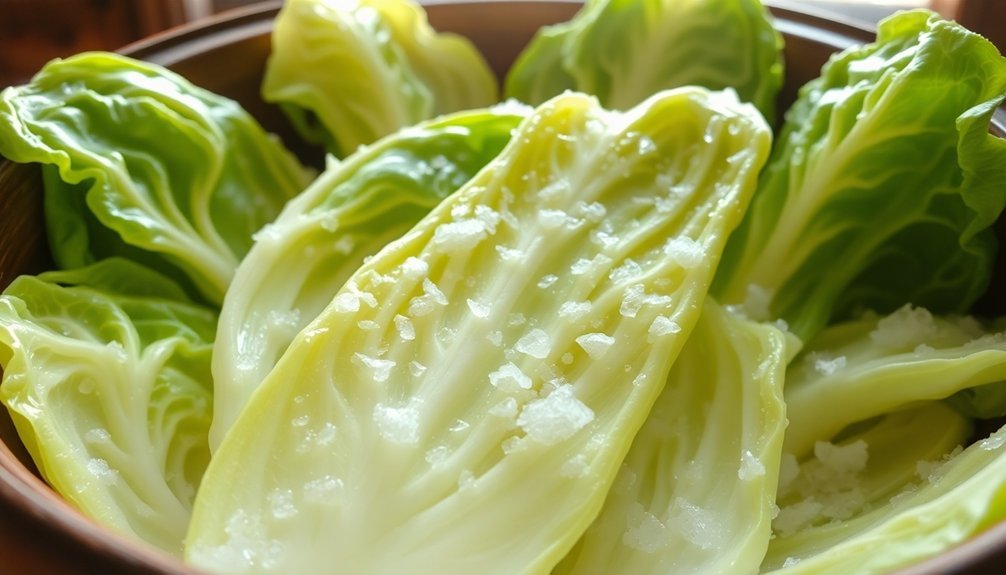
During kimchi fermentation, you'll find that beneficial bacteria like *Leuconostoc mesenteroides* and *Lactobacillus* species thrive and multiply, reaching levels of 9-10 log CFU per gram.
The proper salt concentration creates an ideal environment that encourages these good bacteria while inhibiting harmful microorganisms, leading to a healthy balance of probiotic cultures in your kimchi.
These beneficial bacteria produce lactic acid, acetic acid, and other compounds that not only preserve your kimchi but also provide health benefits like improved digestion and immune system support.
Lactobacillus Growth and Function
The success of kimchi fermentation depends heavily on beneficial bacteria known as Lactobacillus, which thrive in the salty environment created by proper cabbage preparation. The salt creates ideal conditions by suppressing unwanted bacteria while allowing lactobacilli to dominate.
These beneficial bacteria can thrive in both oxygen-rich and oxygen-free environments, making them perfectly suited for kimchi fermentation.
You'll find that temperature plays a vital role in how these bacteria develop. While they'll work at temperatures between 4°C and 10°C, warmer temperatures around 65°F will speed up fermentation, producing more lactic acid and carbon dioxide.
If you prefer complex flavors, cooler temperatures will slow the process down.
The Lactobacillus species in your kimchi work in stages. Leuconostoc mesenteroides kicks off the early fermentation, while Lactobacillus sakei and Lactobacillus plantarum take over later.
These bacteria don't just create kimchi's distinctive taste – they're also working to produce health benefits. They can survive your digestive system, fight harmful bacteria, and may even help with cholesterol reduction, inflammation, and overall gut health.
Healthy Microbial Balance
Maintaining a healthy microbial balance during kimchi fermentation relies on a complex interplay of over 200 bacterial variations. You'll find that lactic acid bacteria (LAB) naturally present on raw ingredients become dominant during fermentation, creating an environment that suppresses harmful bacteria while promoting beneficial ones.
| Bacterial Type | Primary Function | Ideal Temperature |
|---|---|---|
| *Leuconostoc* | Initial fermentation | 4°C |
| *Lactobacillus* | Extended preservation | 10°C |
| *Weissella* | Flavor development | 4-10°C |
The salting process helps establish the right conditions for these beneficial bacteria to thrive. When you consume kimchi, you're getting at least 6 log CFU per gram of probiotics, which greatly enriches your gut microbiota. The fermentation process creates a cascade of beneficial compounds as these bacteria metabolize the ingredients. Temperature plays a vital role – you'll get more Leuconostocspecies at 4°C and a more diverse LAB community at 10°C. The addition of ingredients like red pepper powder and fermented fish sauce further shapes the bacterial community, contributing to kimchi's unique probiotic properties and health benefits, including enhanced immune response and reduced inflammation.
Salt's Role in Fermentation
Salt plays an indispensable role in kimchi fermentation by creating the perfect environment for beneficial bacteria to flourish. When you salt your cabbage, you're initiating a vital process that draws out moisture to create a natural brine. This brine solution isn't just salty water – it's the foundation for successful fermentation, preventing harmful bacteria while promoting the growth of beneficial lactic acid bacteria.
During fermentation, you'll notice several key processes taking place:
- The salt creates an anaerobic environment by submerging the vegetables, protecting them from oxygen exposure.
- Beneficial bacteria convert the vegetables' natural sugars into lactic acid, developing kimchi's signature tangy flavor.
- The salt concentration helps maintain the vegetables' crisp texture by slowing down enzymatic activity.
- A proper 2-3% salt brine guarantees food safety by preventing the growth of harmful microorganisms and mold.
You'll find that using natural, mineral-rich salt works best, as it avoids additives that could interfere with fermentation.
The salt's preservation power extends beyond just preventing spoilage – it's actively working to enhance flavors and create the perfect balance of tanginess and crunch in your kimchi.
Proper Salting Techniques
You'll need to carefully balance your salt ratio, using ½ to 1 cup of natural sea salt or kosher salt for every 2-6 pounds of cabbage to achieve the right kimchi foundation.
When wet brining, soak your cabbage for 1-6 hours depending on your desired saltiness level, or if dry brining, sprinkle the salt directly between cabbage layers and let it sit for 1-2 hours.
Your timing is essential during the brining process, as under-salting won't create the proper environment for fermentation, while over-salting can make your kimchi too salty and inhibit beneficial bacteria growth.
Salt Ratio for Success
Getting the salt ratio right can make or break your kimchi. You'll want to aim for 2-3% salt by weight of your cabbage to create the perfect environment for fermentation. Too much salt will make your kimchi inedible, while too little won't effectively control harmful bacteria.
When you're salting your cabbage, you've got two main methods to choose from:
- Create a saltwater bath by dissolving coarse salt in water
- Sprinkle salt directly onto the cabbage leaves in layers
- Focus on the thick white parts to guarantee even distribution
- Use the resulting brine later in the fermentation process
The salting process isn't just about flavor – it's vital for creating the right conditions for fermentation. As you salt your cabbage, you're helping to draw out moisture, which makes the vegetables crispier.
More importantly, you're creating an environment where good bacteria like Lactobacillus plantarum can thrive while unwanted bacteria are kept in check.
Once you've finished salting, you'll need to rinse the cabbage thoroughly and drain it for about an hour before moving on to seasoning. This step guarantees you'll achieve the perfect balance of flavors in your final product.
Timing Your Brining Process
Mastering the brining timeline is essential for perfectly salted kimchi cabbage. You'll need to soak your quartered Napa cabbage in the brine solution for 4-6 hours at room temperature, though this time can extend to 6-8 hours depending on conditions.
The ideal brining temperature falls between 65-75°F (18-24°C), with warmer temperatures speeding up the process and cooler ones requiring more time.
During the brining period, you'll want to rotate your cabbage every few hours to guarantee even salt distribution and prevent the bottom pieces from becoming too salty.
Keep the cabbage fully submerged using a weighted plate, and don't forget to massage additional salt directly into the core and leafy areas.
Once the brining is complete, you'll need to rinse the cabbage thoroughly 3-4 times with cold water.
After rinsing, gently squeeze out excess water and let it drain in a colander for at least 30 minutes.
Remember to save some of the brine for the fermentation process later.
You can then proceed to chop the cabbage into bite-sized pieces, ready for the next steps in your kimchi-making journey.
Salt's Role in Preservation
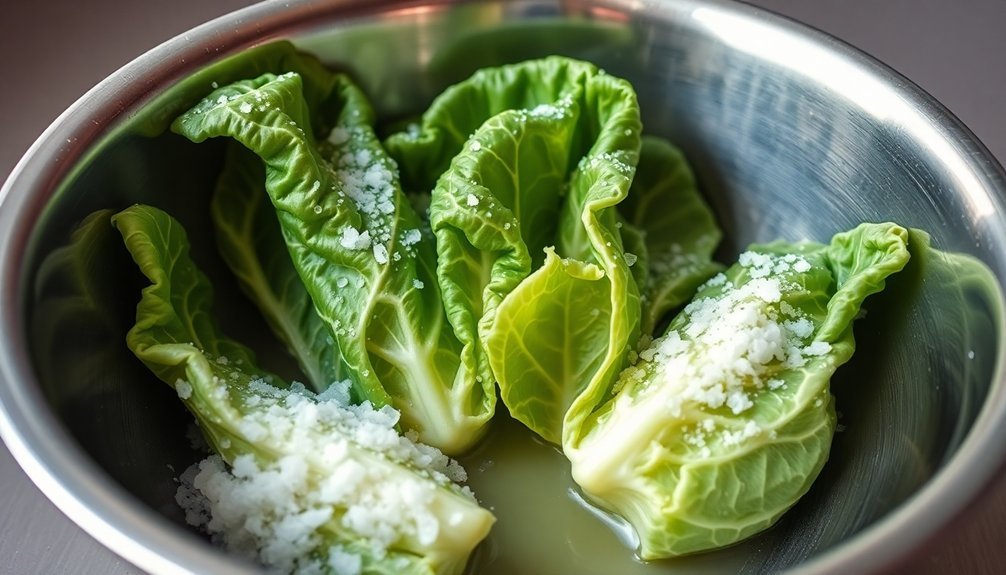
Salt plays multiple essential roles in preserving kimchi, making it one of the most important ingredients in the fermentation process. Through its hygroscopic properties, salt draws out moisture from the cabbage cells, creating an environment that's less favorable for harmful microorganisms while promoting the growth of beneficial bacteria.
When you're making kimchi, salt works in several significant ways to guarantee proper preservation:
- It reduces the water content in cabbage through osmosis, which helps prevent spoilage and allows seasonings to penetrate more effectively.
- It creates an environment where harmful bacteria can't thrive, while beneficial bacteria like Lactobacillus and Weissella species flourish.
- It forms a natural oxygen barrier that inhibits aerobic bacteria growth and promotes proper fermentation.
- It maintains ideal pH levels (around 4.2) for safe fermentation and extended shelf life.
The salt concentration you'll use (typically 2-5%) is essential for achieving these preservation effects. You'll want to use non-iodized salt, as iodized versions can interfere with the beneficial bacteria needed for fermentation.
This careful balance of salt helps create the perfect conditions for both food safety and the development of kimchi's characteristic flavors.
Cultural Heritage of Kimchi Making
The cultural heritage of kimchi-making runs deep in Korean society, stretching back to the Three Kingdoms period over 2,000 years ago.
You'll find that this tradition evolved considerably over time, with a notable change occurring in the early 17th century when Portuguese traders introduced chili peppers to Korea, transforming the recipe into what you know today.
When you participate in kimchi-making, you're joining a tradition that's more than just food preservation.
It's a social cornerstone called Kimjang, where families and communities come together to prepare large quantities of kimchi for winter.
You're taking part in a practice that UNESCO recognized in 2013 as an Intangible Cultural Heritage of Humanity, acknowledging both North and South Korea's traditions.
As you salt the cabbage for kimchi, you're connecting with generations of Koreans who've passed down this knowledge through families and communities.
The process represents Korean values of cooperation, sharing, and living in harmony with nature.
It's become such an integral part of Korean identity that it's sparked international discussions about cultural ownership, as seen in the 1996 dispute with Japan.
Nutrition Through Fermentation
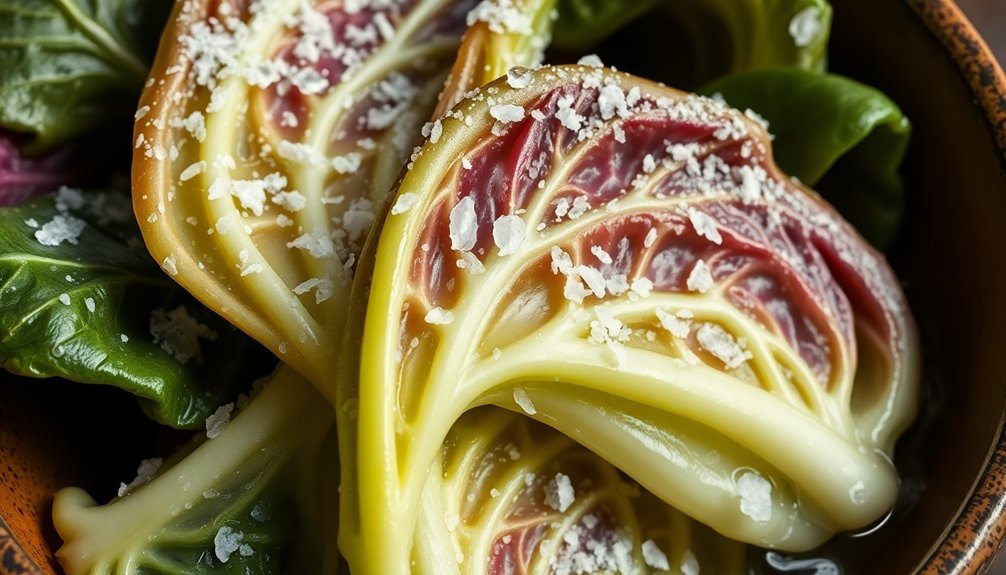
Beyond its rich cultural significance, kimchi's fermentation process creates a nutritional powerhouse that's packed with health benefits. During fermentation, beneficial bacteria transform the salted cabbage into a probiotic-rich food that's easier for your body to digest and absorb.
The fermentation process enhances kimchi's nutritional value in several key ways:
- Your body can better absorb vitamins B6, C, and K, along with minerals like iron and riboflavin, because fermentation breaks down anti-nutrients that typically block nutrient absorption.
- You'll get a healthy dose of probiotics, particularly Lactobacillus plantarum, which supports your gut health and immune system similar to what you'd find in yogurt.
- Your cardiovascular health may improve thanks to compounds like HDMPPA that reduce inflammation and support blood vessel function.
- You're getting powerful antioxidants that fight inflammation and promote healthy aging.
These nutritional benefits aren't just by-products of preservation – they're the result of carefully controlled fermentation that transforms simple salted cabbage into a superfood.
The process creates biologically active compounds that can help manage your weight, blood sugar, and cholesterol levels while supporting your overall health.
Food Safety in Kimchi Preparation
Maintaining proper food safety protocols is vital when preparing kimchi to prevent foodborne illness and confirm successful fermentation. You'll need to pay careful attention to salt concentration, as it's essential for creating the right environment for beneficial bacteria while inhibiting harmful ones. A salt level between 2% and 5% is ideal for proper fermentation and preservation.
You must keep your preparation area clean and follow strict hygiene practices. Always wash your ingredients thoroughly with clean water to remove soil and contaminants, and don't forget to use clean hands or disposable food handler gloves. Raw vegetables can harbor pathogens like E. coli and Salmonella, so proper fermentation is vital for your safety.
To confirm your kimchi is safe to eat, you'll need to monitor the fermentation process carefully. The pH should drop to 4.6 or lower to prevent pathogen growth.
Once fermentation is complete, store your kimchi in the refrigerator and consume it within one week for the best quality. If your kimchi hasn't achieved the proper pH level or shows signs of improper fermentation, don't take chances – discard it immediately.
Temperature and Environmental Factors
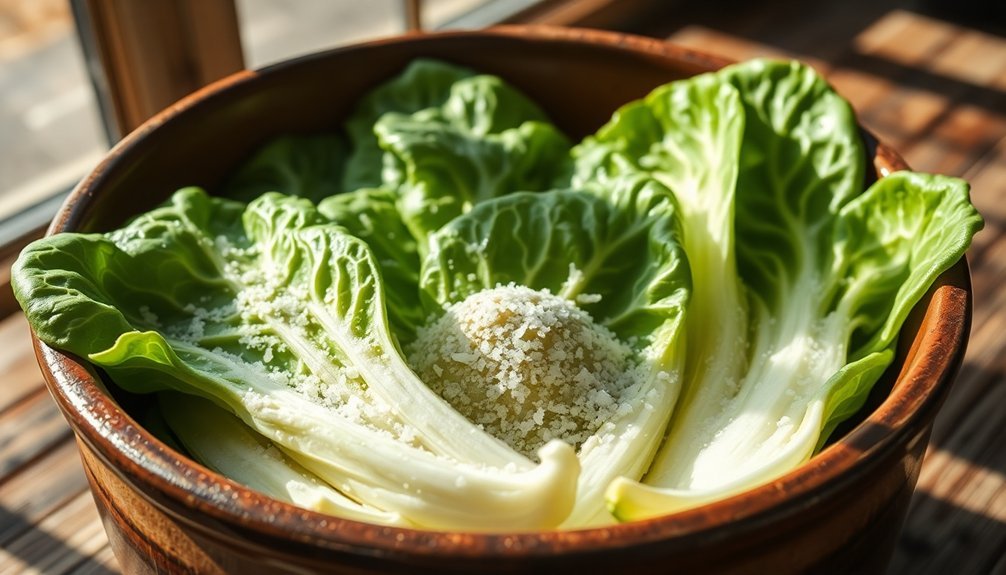
Successful kimchi fermentation depends heavily on maintaining the right temperature range between 50 and 70 degrees Fahrenheit. At 65 degrees, you'll achieve the perfect balance of bacterial activity, resulting in those desirable mellow fishy and cheesy notes, along with the signature fizz and crunch that make kimchi so appealing.
The temperature you choose will directly impact your kimchi's fermentation process. Here's what you need to know:
- Warmer temps (around 70°F) speed up fermentation but can make your kimchi too sour quickly due to increased lactobacilli activity.
- Cooler temps (around 50°F) slow down fermentation, developing more complex flavors but taking longer to reach the desired taste.
- Traditional Korean methods use cool underground pits to maintain ideal temperatures.
- Room temperature fermentation takes 1-2 days, while refrigerated fermentation progresses more slowly.
You'll want to monitor your fermentation environment carefully, as consistent temperature is essential for success.
If you're fermenting at home, consider using a cooler spot like a basement or garage to mimic the traditional pit fermentation method, especially if your kitchen tends to run warm.
Regional Salting Variations
You'll notice distinct salting methods across Korea's regions, with coastal areas traditionally preferring mineral-rich sea salt that's harvested locally from their shorelines.
Mountain regions often use less salt in their kimchi due to historically limited access to sea salt, leading to faster fermentation times and different preservation techniques.
Seaside regions like Jeolla tend to be more generous with their salt usage, which helps balance the abundance of seafood ingredients in their kimchi varieties.
Salt Methods By Region
Three distinct approaches to salting cabbage for kimchi have evolved across different regions, each reflecting local traditions and taste preferences.
Some areas favor a quick salting process of just 1-2 hours to maintain the cabbage's crunchiness, while others opt for extended periods of up to 8 hours for deeper seasoning penetration.
You'll find that regions differ not only in timing but also in their salting methods.
While some traditionally use a saltwater brine solution, others prefer direct salt application.
These regional variations typically align with local climate conditions and cultural preferences for texture and flavor profiles.
Here are the main regional differences you'll encounter:
- Coastal regions often use a stronger brine solution (4-5% salt concentration) and shorter salting times.
- Mountain regions typically prefer direct salt application with periodic rotation every 2-3 hours.
- Urban areas commonly use a moderate approach with 2-3% salt concentration and 3-4 hour salting time.
- Southern regions tend to combine both methods, starting with direct salting followed by a brine solution.
The salting method you choose will greatly impact your kimchi's final texture and fermentation speed, with each approach producing distinctly different results.
Traditional Coastal Salt Preferences
Along Korea's coastal regions, traditional salt-makers have long relied on Shinan sea salt for creating the perfect kimchi. This distinct salt, harvested from pristine waters in a UNESCO Biosphere Reserve, offers unique properties that you won't find in regular table salt. With its lower sodium chloride content and higher mineral levels, Shinan salt provides the best foundation for kimchi fermentation.
You'll find that this traditional salt undergoes a meticulous three-year aging process, eliminating bitter notes while preserving essential minerals like calcium, potassium, and magnesium. When you're salting cabbage leaves, the coarse texture guarantees even distribution and prime fermentation.
Major Korean food companies, including CJ, Daesang, and Nongshim, choose this salt for its ability to maintain balanced sourness and prevent over-ripening.
If you're concerned about quality, you can trace each batch through its unique serial number and QR code. The salt's eco-friendly harvesting methods and indefinite shelf life make it a reliable choice for traditional kimchi-making.
You'll notice how it contributes to the depth of flavor in your fermented foods while maintaining the authentic taste that Korean cuisine is known for.
Mountain Vs Seaside Techniques
While Shinan sea salt remains a cornerstone of coastal kimchi-making, distinct regional techniques have evolved across Korea's varied landscape.
You'll find that mountain and seaside regions have developed their own unique approaches to salting and fermenting kimchi, largely influenced by their local climates and available ingredients.
In mountain regions, you'll notice less salt is used due to slower fermentation rates in the cooler climate, while seaside areas require more salt to combat higher humidity and warmer temperatures.
The key differences between these regional approaches include:
- Fermentation timing – Mountain regions need longer fermentation periods due to cooler temperatures, while coastal areas complete the process more quickly.
- Salt concentration – Seaside regions use higher salt amounts to prevent spoilage, whereas mountain areas use less to avoid over-salting.
- Ingredient adaptation – Coastal recipes often incorporate seafood and seaweed, while mountain versions emphasize local vegetables and herbs.
- Storage methods – Mountain communities typically ferment at room temperature, while seaside areas often use cool storage to slow down the process.
The regional variations in salting techniques directly impact the final taste and texture of your kimchi, creating distinct flavor profiles unique to each area.
Frequently Asked Questions
Can I Make Kimchi Without Salting the Cabbage First?
You can make kimchi without salting, but you won't get the best results. Your kimchi might spoil faster, have uneven flavoring, and lack the traditional texture. It's safer to follow the salting method.
What Happens if I Accidentally Oversalt My Kimchi Cabbage?
If you've oversalted your kimchi cabbage, you can add radish chunks to absorb excess salt – leave them for 24 hours. Alternatively, you can use the cabbage in kimchi stew where extra saltiness won't matter.
Is It Possible to Speed up the Salting Process?
Yes, you can speed up cabbage salting by using warm saltwater instead of dry salt, cutting smaller pieces, and pressing down with weights. However, don't rush too much or you'll compromise the kimchi's texture.
Can I Reuse the Saltwater Brine From a Previous Kimchi Batch?
You can reuse kimchi brine for pickles, marinades, and as a starter culture for new ferments. However, don't use it repeatedly as its effectiveness diminishes over time. Store it properly in the fridge.
Why Does My Kimchi Smell Different From Store-Bought Versions?
Your kimchi's unique smell likely comes from differences in fermentation temperature, ingredient ratios, and duration. Store-bought versions use controlled environments and standardized recipes, while home fermentation creates varied, personalized results.
In Summary
You've learned that salting cabbage is vital for authentic kimchi making. It draws out excess moisture, creates the perfect environment for beneficial bacteria, and helps develop that signature crunch. By following proper brining techniques, you'll guarantee your kimchi ferments safely and develops complex flavors. Whether you're using coarse sea salt or Korean solar salt, this essential step transforms ordinary cabbage into a probiotic-rich Korean staple.

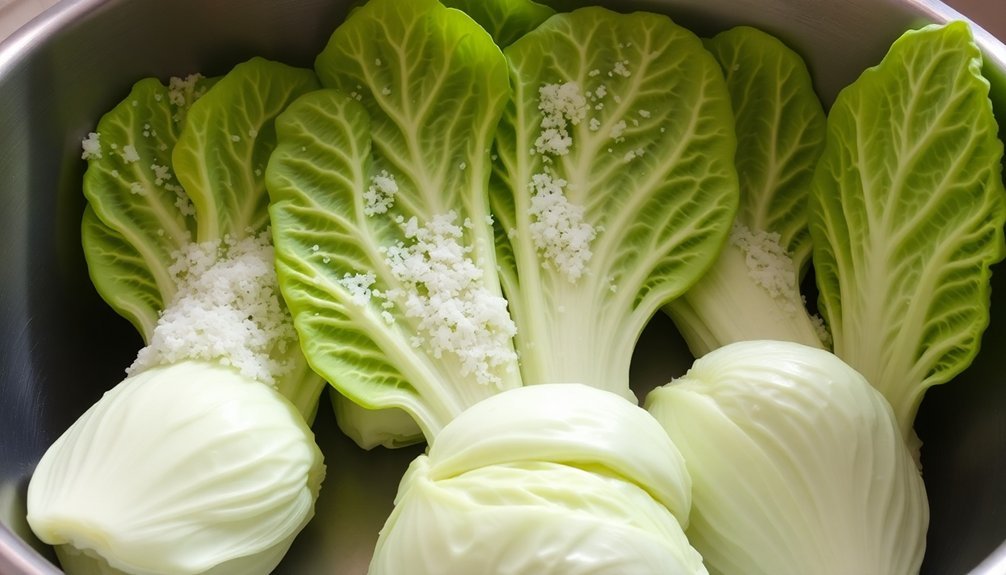



Leave a Reply